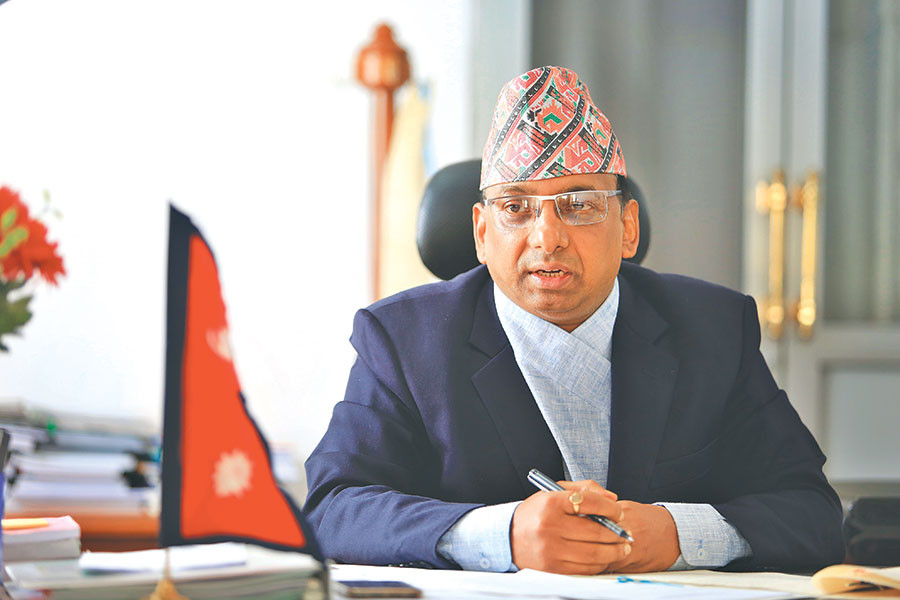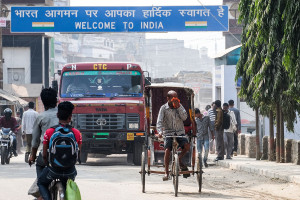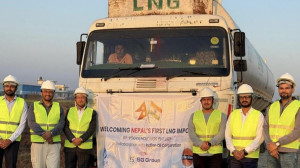Money
‘Govt needs Rs820b to build offices and human capacity at local bodies’
Construction of crucial physical infrastructure projects that are required to unlock private investment and rekindle economic growth may not move ahead at a desired pace in this fiscal year as well, as the government’s capital spending has not shown signs of gathering speed.
Construction of crucial physical infrastructure projects that are required to unlock private investment and rekindle economic growth may not move ahead at a desired pace in this fiscal year as well, as the government’s capital spending has not shown signs of gathering speed. The government’s capital expenditure stood at 4.6 percent of the allocated capital budget of Rs335.2 billion in the first quarter of the current fiscal year. The snail-paced capital spending was recorded at a time when annual budget was presented in and approved by Parliament before the start of the new fiscal year. Rupak D Sharma of The Post caught up with Finance Secretary Shanta Raj Subedi, who retired on Wednesday, to discuss this issue, and problems seen in industrialisation process and implementation of fiscal federalism. Excerpts:
The government was able to spend only 4.6 percent of the total capital budget in the first quarter of this fiscal year. This is a clear indication that capital spending has failed to pick up speed. Why is this problem recurring every year?
We did rejig the budgetary system this year to expedite capital spending. First of all, the budget was presented in Parliament on May 29, one-and-a-half months prior to the start of the current fiscal year. The budget document allowed different ministries to utilise available funds, and implement projects and programmes without seeking permission of any authority. This was a new approach to budget implementation. Also, on May 30 the Ministry of Finance introduced a guideline on budget implementation. That guideline clearly says ministries should lay the groundwork for budget implementation prior to the start of fiscal year or within mid-August at the latest. The Finance Ministry also said different ministries must allocate budget to different departments and units within July 30, and frame directives and guidelines for programme implementation within August 16. The ministry also said contractors should be appointed within October 17 to execute various works. These measures should have facilitated budget implementation. But that has not happened because ministries could not work as per our instruction. For instance, many line ministries could not appoint contractors within October 17. There was also delay in formulation of manuals, hiring of temporary staff and allocation of budget to different departments
and units.
The Ministry of Finance has introduced Line Ministry Budgetary Information System (LMBIS) to streamline budget implementation. Despite this, why are ministries failing to utilise available funds on time?
As per the LMBIS, ministries have to achieve certain targets every four months. This fiscal year, ministries have to utilise 29 percent of the budget within first four months. This target was fixed by line ministries themselves, and not by the Finance Ministry. But line ministries are unlikely to meet this target. We recently called secretaries of all the ministries and informed them about their failure to fulfil their own commitments. They have said they may not be able to meet the target in the first four months but will make recovery in the coming days and meet the targets of the next two four-month periods. Some of the ministries said the devastating floods in Tarai have hit project execution. But we have told them not to make excuses and focus on meeting their targets.
Ministries are supposed to enter projects in LMBIS after conducting their viability study. Yet problems related to delay in appointment of contractors and formulation of manuals are cropping up. Why?
Many ministries were too ambitious at the time of enrolling programmes and projects in the LMBIS. That’s one problem. Another big problem is lengthy process of conducting environmental impact assessment. Also, the country faces shortage of construction materials from time to time, and in some cases contractors have delayed works or fled. These are some the factors delaying project implementation. Another problem is government staff’s inefficiency in project execution, which is one of the shortcomings of the bureaucracy.
Another problem is haphazard inclusion of projects in the budget, isn’t it? The government introduced LMBIS to uproot this problem. But the budget of this year incorporated a programme on expansion of runway at Tribhuvan International Airport by building an underpass in Koteshwor. Officials say this programme was not included in LMBIS but appeared in budget document. How did this happen?
The LMBIS was introduced to abolish the practice of haphazard entry of programmes in the annual budget. The Ministry of Finance approves budgetary programmes based on what has been included in the LMBIS. However, some of the projects are incorporated in the budget because of political interest. Everyone agrees the runway of the international airport must be expanded to park more aircraft. And the Civil Aviation Authority of Nepal (Caan) has been working on this for quite some years. So, the new programme is a part of the ongoing airport expansion project.
Nobody is saying the new project is unviable. But why was it incorporated in the budget without consulting concerned authorities?
Well, some projects appear in the budget document because they are of political interest.
How frequently do politicians interfere in budget formulation process?
Annual budget, in fact, is a political document. Budget is formulated by finance minister, who is a political figure. Also, every minister wants to include some of his or her pet projects in the budget to please voters. This is why different ministries are given budgetary ceilings, based on which programmes have to be proposed. This, however, does not mean such projects should create a financial burden on the state.
You worked as a chief tax administrator for quite a long time. It is said country’s revenue collection model, which is dependent on imports, is flawed, as it is widening trade deficit. What is your take on this issue?
Our annual revenue collection growth rate has stood at around 22 to 23 percent for quite some years. In the last fiscal year, for instance, revenue as a share of GDP stood at 23.4 percent, which is one of the highest in South Asia. This is encouraging as least developed countries generally do not achieve such results. But what is the source of our revenue? This is an important question. As you said, most of it comes from taxes and duties imposed on imported goods. But this is natural because our economy is led by trading activities. To reduce the share of taxes and duties generated by imports in revenue collection, we must strengthen our industrial sector and focus on production. This will automatically replace imports, bridge trade gap, create jobs, curb labour flight and give a boost to revenue collection.
Nepal has embarked on a journey of deindustrialisation before industrialisation process could properly take off. This also happened because the government could not introduce appropriate policies to enhance domestic production, isn’t it?
I agree the effort made by the government to promote industrialisation hasn’t been sufficient. We lack policies and there are bureaucratic hurdles as well. But, unfortunately, the country’s private sector has not been able to take a lead in industrialisation process as well. We have extended loans at subsidised interest, subsidies to promote commercial farming, tax holidays, and tax discount and exemption on imports of capital goods to the private sector to promote industrialisation. But these measures have not yielded desired results. The private sector is less effective and efficient in Nepal probably because it has not undergone a transformation, as many big businesses are still run by families. For example, we have not been able to tap hydro resources, which are in abundance. As a result, we are still importing electricity despite having the capacity to export power. We, however, hope to see more positive results in the coming days as the new Industrial Enterprise Act includes a number of provisions to promote industrialisation and the private sector.
The government’s efforts to promote industrialisation seem half-hearted. Take a look at the first special economic zone, where the government has not been able to supply 20MW of power. Isn’t that a pity?
The special economic zone is not fully occupied. So, if we supply 20MW of electricity to the zone, other areas may face power shortage. We, thus, have to strike a balance carefully. But we are committed to catering quality service and providing other incentives, such as tax rebates, to manufacturing units that have set up bases in the zone. We are also committed to building special economic zones in other places as well to promote production and exports.
The country has now moved from unitary to federal government system. But many local and provincial bodies do not have their own offices or qualified human resources. How do you intend to address this problem?
We will need huge financial resources to build physical infrastructure and capacity of human resources at local and provincial level. As per a latest study, the government will need Rs820 billion to build physical infrastructure, especially office infrastructure, and capacity of human resources at local bodies. This is a preliminary estimate. It is my assumption that we will need even more funds to build human capacity and buildings at seven provinces.
Does this mean public expenditure will soar in the coming years?
Yes, next four to five years will see high recurrent and capital expenditure. Efforts should, therefore, be made to enhance income generation capacity of local and provincial bodies so that they can build infrastructure and capacity of human resources on their own.
But most of the local bodies do not know how to generate revenue and prioritise expenditure. Won’t this create problems?
The central government will now have to share certain portion of the revenue with subnational governments and use a portion of what is remaining to extend grants to local and provincial bodies. This will cause the size of the central government’s budget to shrink. Against this backdrop, local and provincial bodies should work efficiently and look for ways to become self-reliant in income generation. If they fail to generate income effectively and efficiently, the central government may not be able to do much. This is a big challenge in the process of institutionalising federalism. So, local and provincial governments should mobilise financial resources and spend efficiently.
Considering the existing capacity of local and provincial bodies, it could be said the country’s fiscal deficit will widen in the coming days, isn’t it?
Implementation of federalism is likely to cost us more than what we had initially estimated. But again federalism is a new concept in the country and we are currently in a transitional phase. However, we can make avoid pitfalls if we utilise resources efficiently. In this regard, politicians should not lend support to populist programmes that can increase financial burden on the state. Also, profligate spending should be avoided. This generally means the government should manage resources properly. So, caution should be taken while framing fiscal policy and programmes incorporated in the budget should support capital formation.




 16.12°C Kathmandu
16.12°C Kathmandu














